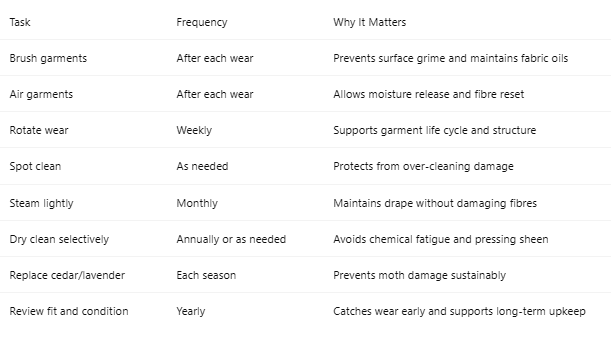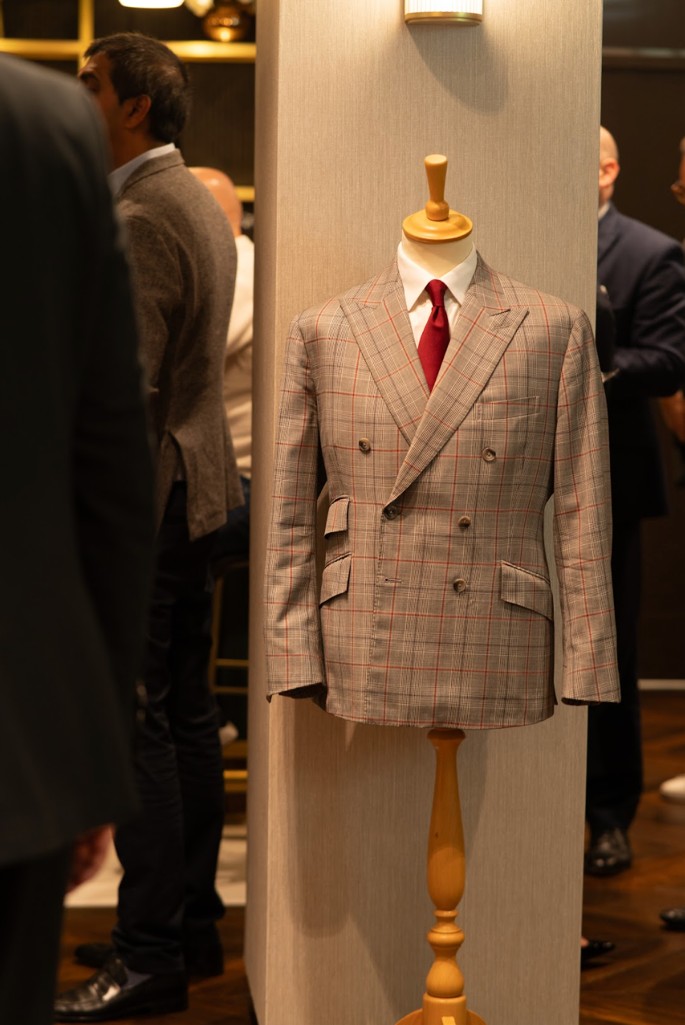How do you properly care for wool suits, coats, and trousers?
Caring for wool garments starts with recognising their particular needs. Unlike cotton or synthetics, wool is a natural fibre that responds to its environment. Suits, coats, and trousers require more than the occasional dry clean. From daily airing to the right hanger choice, each decision plays a role in maintaining their shape and extending their life. This kind of tailored garment upkeep ensures your investment remains sharp, structured and long-lasting.
What Is In This Article
Why wool tailoring requires more than just cleaning
Wool tailoring is more than clothing, it is a reflection of self. A well-cut suit or structured coat provides warmth, but more importantly, it carries a sense of confidence. Whether bespoke or high-end ready-to-wear, these garments deserve more than a simple dry clean.
Detailed construction techniques such as canvassing and careful lining make wool tailoring vulnerable to damage when mistreated. Frequent cleaning accelerates fabric fatigue, while neglect allows subtle wear to take hold.
Caring for wool should feel less like a task and more like a ritual of respect. Gentle brushing, thoughtful storage, and mindful airing all contribute to preserving the bespoke integrity of each piece. Just as you would care for a cherished instrument, these habits safeguard your investment.
You do not just wear wool. You preserve it.
Pro Tip: Let your wool rest for 48 hours between wears to help preserve shape memory and prevent fibre stress.
Garment Refresh Consultation
Let our experts evaluate your suit’s structure, fit and fabric health with a professional refresh session.
Understanding fabric types: tweed, flannel and fine wool
Why fabric type affects your wool care routine
Wool takes many forms, each with unique care needs. Tweed is thick and textured, flannel soft and warm, and worsted wool sleek and smooth. These variations affect how the garment breathes, stretches, and holds its shape.
Due to its density, tweed benefits from regular airing to release trapped odours. Fine wool creases more easily and needs recovery time between wears. Understanding what your garment is made of helps avoid damaging assumptions or overgeneralised care.
Common fabric types and their characteristics
-
Tweed: Dense and rugged, best for outerwear. Requires good airflow between wears.
-
Flannel: Soft with a brushed surface, ideal for winter. Absorbs moisture and benefits from fibre relaxation.
-
Worsted Wool: Sleek and formal. Holds its structure but can show sheen from frequent use.
When you know your fabric, looking after it becomes much easier.
Wool fabric comparison: care levels and performance
This comparison gives a clearer view of what each wool type needs to stay in top condition.

Pro Tip: Avoid mothballs. Instead, use cedar blocks or lavender in breathable garment bags for natural protection.
Daily rituals: brushing, airing and wool-friendly habits
Daily wool care routines that preserve longevity
Simple daily actions have a lasting impact. After wearing, place your jacket or coat on a wide wooden hanger that matches the shoulder width. Let it air in a well-ventilated spot away from direct sunlight. Wool fibres require space to relax and release moisture.
Use a soft-bristled garment brush to lift away dust and surface grime. Stroke gently in the direction of the weave to avoid damaging the fabric. This process stimulates the wool’s natural oils, keeping the surface refreshed.
To remove light creases, use a vertical steamer at a safe distance. Avoid direct pressure, as the fibres respond better to gentle steam diffusion.
Spending just two minutes each day can dramatically extend your garment’s lifespan. This habit is at the heart of effective tailored garment upkeep.
How often should you wear, rest and rotate wool garments?
Like a fine pair of shoes, wool garments need time to recover. Wearing the same suit or trousers day after day strains the lining and compromises the fabric’s memory.
Follow the three-day rule: give each piece at least 48 hours to rest after wearing. This rest period allows shape memory to return and moisture to evaporate naturally.
Rotate jackets and trousers regularly. Hang coats properly and avoid folding them. Keep an eye on high-stress areas such as knees, shoulders, and seams.
A wool suit, like a good bottle of wine, benefits from time to breathe. Regular rotation supports wardrobe sustainability and extends cost-per-wear value.
Host or Attend Exclusive Style Events
Want to create or join an event like Bespoke & Brogues? We help bring together people who value quality and connection.
Proper hanging and wardrobe conditions for wool care
Storage choices directly affect garment shape. Choose broad, contoured wooden hangers that support the structure of your suits and coats. Avoid wire hangers altogether, as they distort shoulder lines and compromise fit.
Clip hangers are best for trousers. Secure them by the hem to protect pleats and avoid stretching. Leave enough space between garments to support airflow and prevent creasing.
Use cotton or muslin garment bags to protect wool while allowing it to breathe. Plastic coverings trap moisture and can lead to mildew or moth damage. Include cedar or lavender to keep pests at bay.
Think of your wardrobe as a microclimate. Manage it well.
Dry cleaning or spot cleaning: what does wool really need?
Dry cleaning has its place but should be used sparingly. Chemical treatments weaken wool fibres and may create an unwanted shine.
Reserve dry cleaning for serious spills, embedded odours, or annual refreshes. For day-to-day upkeep, spot clean with gentle soap and a soft cloth. This helps maintain the natural finish and fabric memory.
Use a vertical steamer to relax wrinkles. Never apply pressure, as the steam will do the work without harming the fabric.
Before heading to the cleaners, ask whether a light brush or steam might solve the issue. For the best results, choose Woolmark-approved services or products that meet their wool care standards.
How to store tailored wool in off-seasons
Proper storage helps garments return ready for wear. Always store clean, fully dried items to avoid mould and attractants for moths.
Opt for breathable bags made of cotton or muslin. Add cedar blocks or lavender sachets to deter pests naturally. Never use mothballs, as they are outdated and harsh.
Fold trousers with tissue inside the crease to retain their line. Hang coats and suits to protect their structure. Make sure your storage area is cool, dry, and well-ventilated.
Out of sight does not mean out of care. The Woolmark Company recommends breathable materials and moth-safe practices as part of moth-proof wool storage.
Suit, coat or trousers: how care varies by garment
Wool garments vary, so your care routine should too:
For suits:
-
Use shaped wooden hangers to preserve drape.
-
Rotate to reduce fabric stress.
-
Light steaming keeps the silhouette crisp.
For coats:
-
Choose hangers that match shoulder width to prevent sagging.
-
Air coats regularly, particularly after damp weather.
-
Use cedar to maintain freshness and protect from moths.
For trousers:
-
Hang from the cuffs to protect creases.
-
Rotate often to minimise shine and fabric fatigue.
-
Insert tissue if folding for long-term storage.
Each item plays a part in your overall look. Care for each accordingly.
Fixing wool problems: shine, shape loss and moth damage
Wool is forgiving when treated properly. If you spot shiny elbows or knees, use a steamer and a soft brush to restore texture. Never press directly, as this locks in the damage.
Reshape collapsed shoulders or lost pleats by steaming and carefully guiding the garment back into form. Regular maintenance reinforces the fabric’s memory.
For moth damage, isolate the garment immediately. Place it in a sealed bag and freeze for three days to kill larvae. Follow up with a professional tailor for discreet mending.
Many common issues do not require replacement. Most can be corrected.
Tailoring is an investment. Caring for it should be too
These garments reflect craftsmanship and personal style. Caring for them is a way to protect that value.
Long-term care reduces environmental impact and improves cost-per-wear. With proper upkeep, a tailored suit from Fielding & Nicholson can outlast trends and serve you for years.
You invested in quality. Let that investment continue.
The ultimate wool wardrobe care checklist

Consistency in care brings long-term reward.
Your tailor’s role in wool garment care
Your tailor remains your ally beyond the fitting room. Their insight can help prolong the life of each garment.
Fielding & Nicholson, along with members of the British Tailors Guild, provide guidance on garment rotation, hanger use, and post-season reviews. Some offer steam refreshing and structural tweaks to keep your clothes in their best form.
Tailors can spot tension in linings, misaligned shoulders, and early signs of wear. Trust their eye for detail.
Book a seasonal check-up. Your wardrobe will thank you.







